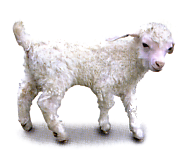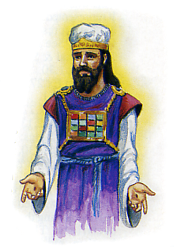|
The Daily Services
Not only the sanctuary itself, but the ministration of the priests, was to "serve unto the example and shadow of heavenly things" (Hebrews 8:5). Thus it was of great importance; and the Lord, through Moses, gave the most specific instruction concerning every point of this typical service.
The ministration of the sanctuary consisted of two divisions, a daily and a yearly service. The daily service was performed at the altar of burnt offering in the court of the tabernacle and in the holy place; while the yearly service was in the most holy place.
The daily service consisted of the morning and evening burnt offering, the offering of sweet incense on the golden altar, and the special offerings for individual sins. And there were also offerings for sabbaths, new moons, and special feasts.
Every morning and evening a lamb of a year old was burned upon the altar, with its appropriate meat offering, thus symbolizing the daily consecration of the nation to
 Jehovah and their constant dependence upon the atoning blood of Christ. God expressly directed that every offering presented for the service of the sanctuary should be "without blemish" (Exodus 12:5). Only an offering "without blemish" could be a symbol of His perfect purity who was to offer Himself as "a Iamb without blemish and without spot" (1 Peter 1:19).
Jehovah and their constant dependence upon the atoning blood of Christ. God expressly directed that every offering presented for the service of the sanctuary should be "without blemish" (Exodus 12:5). Only an offering "without blemish" could be a symbol of His perfect purity who was to offer Himself as "a Iamb without blemish and without spot" (1 Peter 1:19).
In the offering of incense, the priest was brought more directly into the presence of God than in any other act of the daily ministration. As the inner veil of the sanctuary did not extend to the top of the building, the glory of God, which was manifested above the mercy seat, was partially visible from the first apartment. When the priest offered incense before the Lord, he looked toward the ark; and as the cloud of incense arose, the divine glory descended upon the mercy seat and filled the most holy place, and often so filled both apartments that the priest was obliged to retire to the door of the tabernacle. As in that typical service the priest looked by faith to the mercy seat which he could not see, so the people of God are now to direct their prayers to Christ, their great High Priest, who, unseen by human vision, is pleading in their behalf in the sanctuary above.
The incense, ascending with the prayers of Israel, represents the merits and intercession of Christ, His perfect righteousness, which through faith is imputed to His people, and which can alone make the worship of sinful beings acceptable to God.
As the priests morning and evening entered the holy place at the time of incense, the daily sacrifice was ready to be offered upon the altar in the court without. Before entering into the presence of God through the ministration of the priest, they were to engage in earnest searching of heart and confession of sin. They united in silent prayer, with their faces toward the holy place. Thus their petitions ascended with the cloud of incense, while faith laid hold upon the merits of the promised Savior prefigured by the atoning sacrifice.
The showbread was kept ever before the Lord as a perpetual offering. Thus it was a part of the daily sacrifice. It was called showbread, or "bread of the presence," because it was ever before the face of the Lord. It was an acknowledgment of man's dependence upon God for both temporal and spiritual food, and that it is received only through the mediation of Christ. God had fed Israel in the wilderness with bread from heaven, and they were still dependent upon His bounty, both for temporal food and spiritual blessings. Both the manna and the showbread pointed to Christ, the living Bread, who is ever in the presence of God for us. He Himself said, "I am the living Bread which came down from heaven" (John 6:48-5 1).
The most important part of the daily ministration was the service performed in behalf of individuals. The repentant sinner brought his offering to the door of the tabernacle, and, placing his hand upon the victim's head, confessed his sins, thus in figure transferring them from himself to the innocent sacrifice. By his own hand the animal was then slain, and the blood was carried by the priest into the holy place and sprinkled before the veil, behind which was the ark containing the law that the sinner had transgressed. By this ceremony the sin was, through the blood, transferred in figure to the sanctuary.  In some cases the blood was not taken into the holy place; but the flesh was then to be eaten by the priest, as Moses directed the sons of Aaron, saying, "God hath given it you to bear the iniquity of the congregation" (Leviticus 10:17). Both ceremonies alike symbolized the transfer of the sin from the penitent to the sanctuary. In some cases the blood was not taken into the holy place; but the flesh was then to be eaten by the priest, as Moses directed the sons of Aaron, saying, "God hath given it you to bear the iniquity of the congregation" (Leviticus 10:17). Both ceremonies alike symbolized the transfer of the sin from the penitent to the sanctuary.
Such was the work that went on day by day throughout the year. The sins of Israel being thus transferred to the sanctuary, the holy places were defiled, and a special work became necessary for the removal of the sins. God commanded that an atonement be made for each of the sacred apartments, as for the altar, to "cleanse it, and hallow it from the uncleanness of the children of Israel" (Leviticus 16:19).
|


